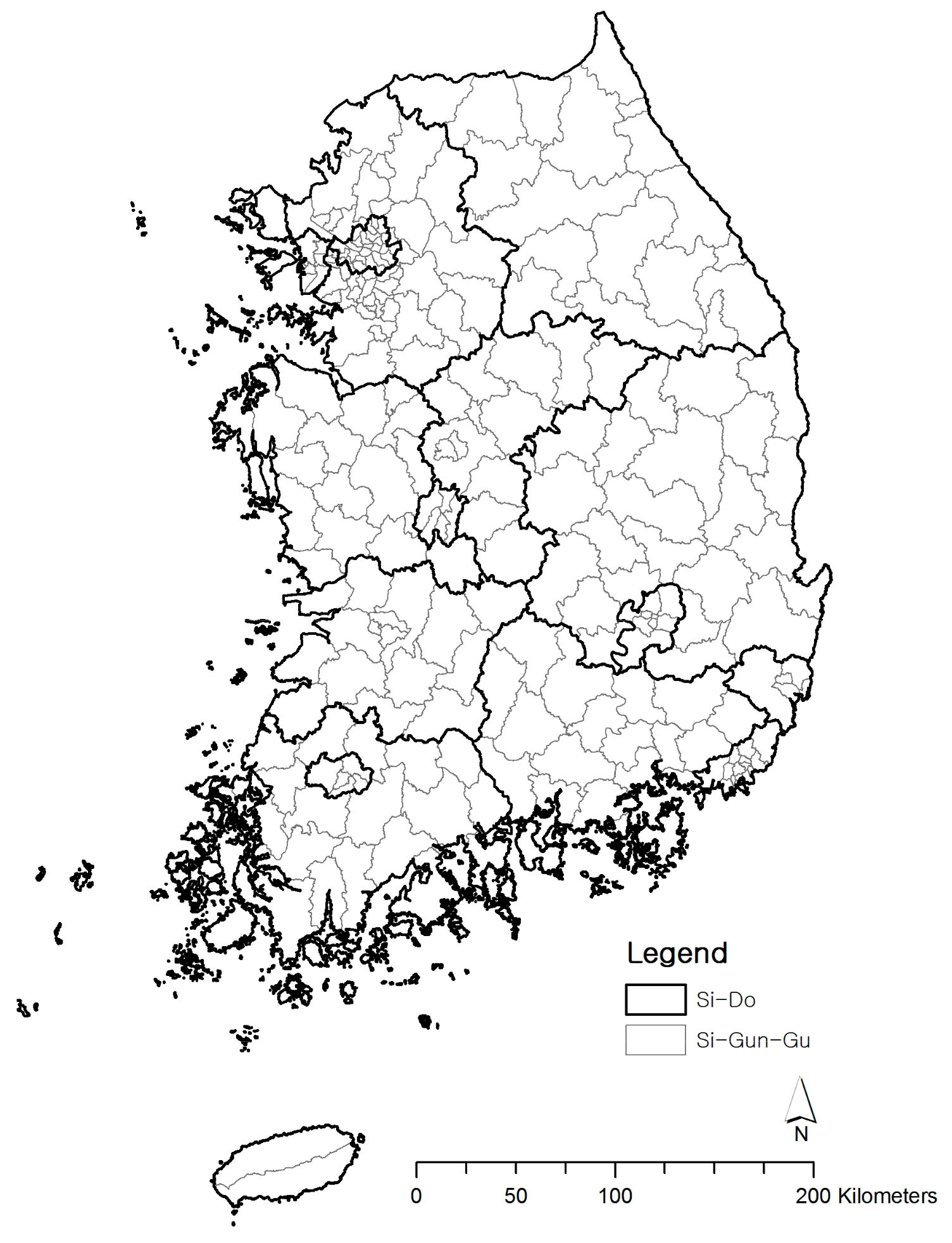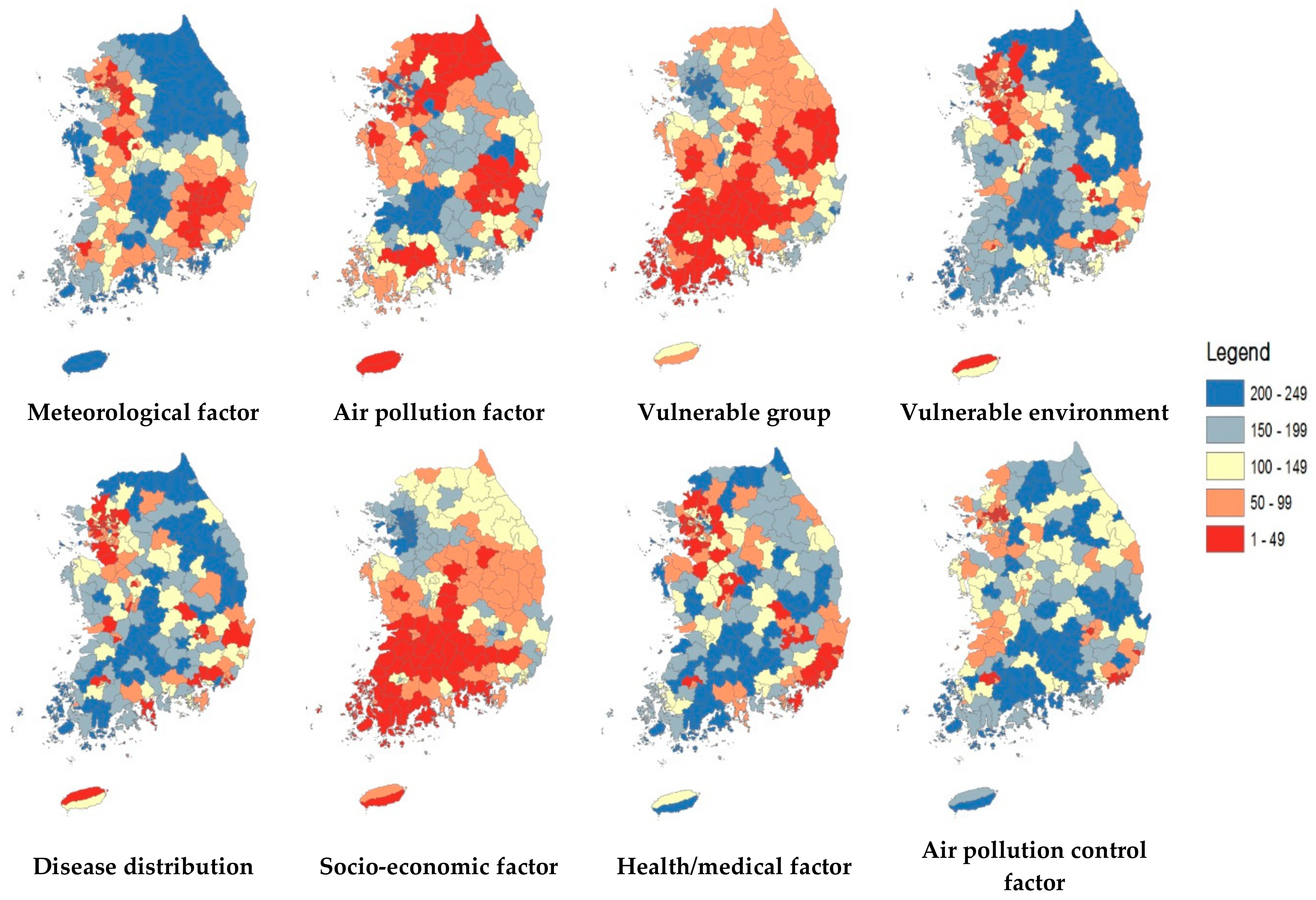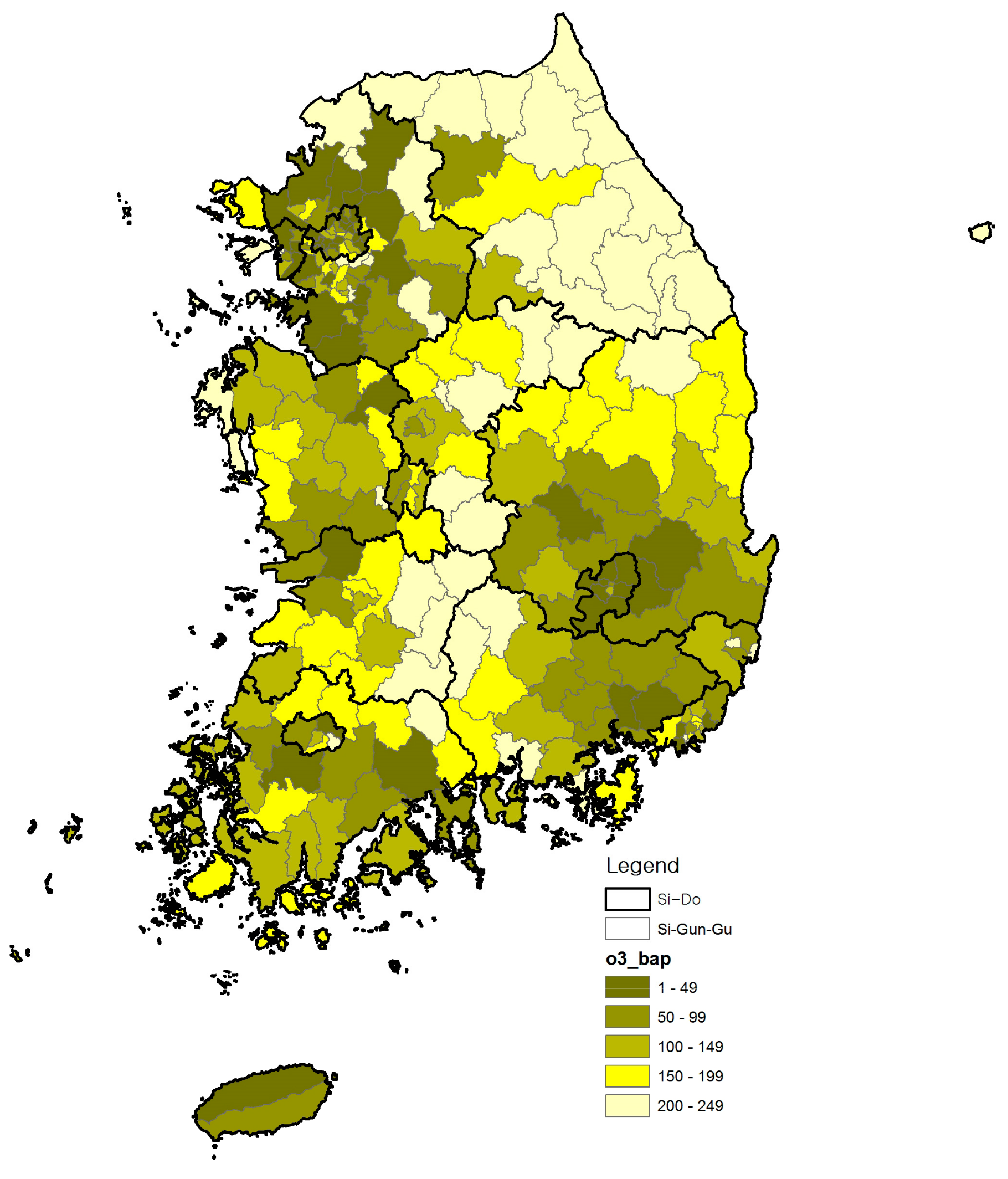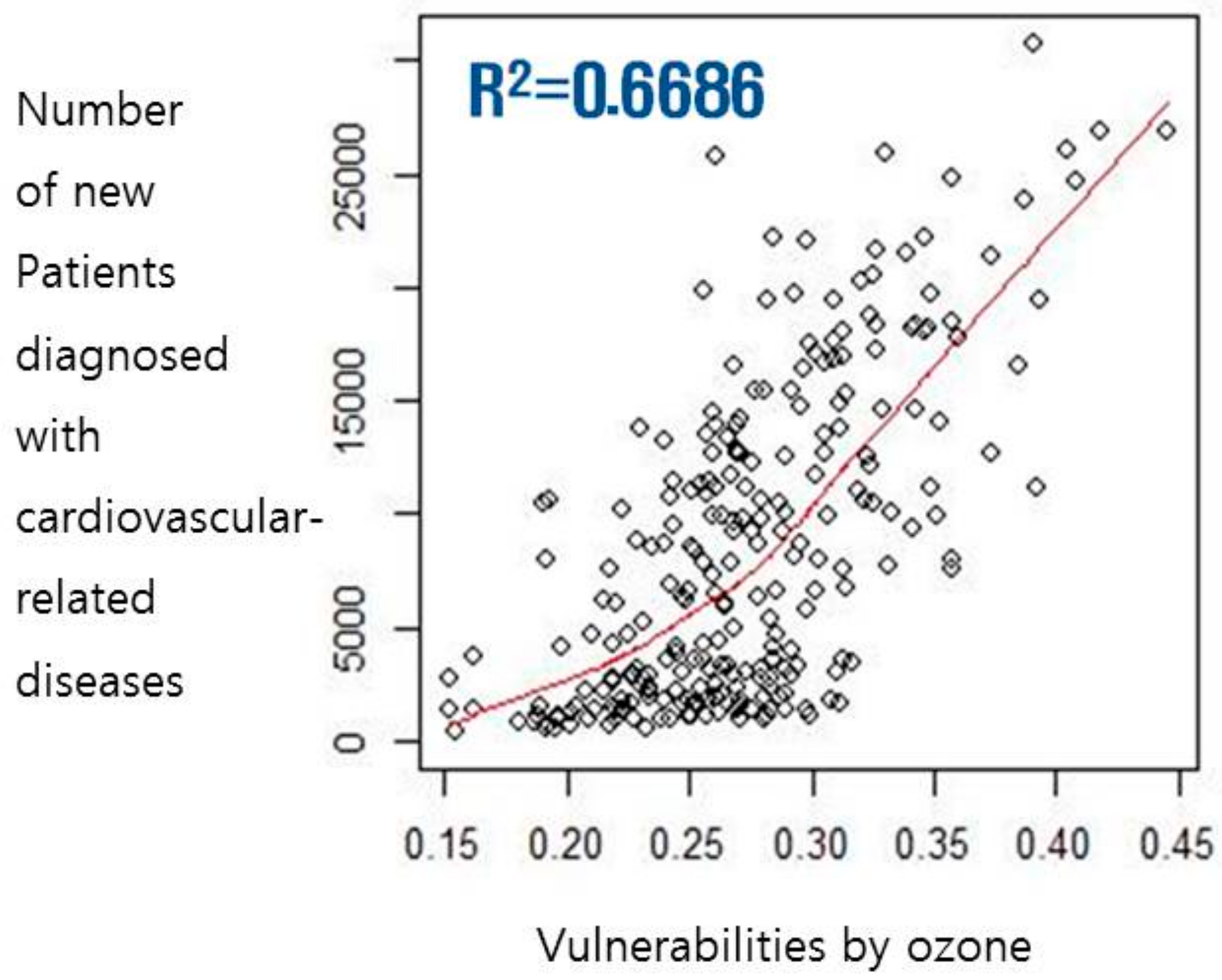Assessing the Health Vulnerability Caused by Climate and Air Pollution in Korea Using the Fuzzy TOPSIS
Abstract
1. Introduction
2. Materials and Methods
2.1. Study Area
2.2. Research Method
3. Results
3.1. Selecting Indicators for the Vulnerability Assessment of the Health Effects of Climate Change and Air Pollution
3.2. Basic Statistics and Weights in Assessing the Health Vulnerabilities Caused by Climate Change and Ozone
3.3. Assessing the Heath Vulnerability Caused by Climate Change and Air Pollution Using the Fuzzy TOPSIS
3.4. Verifying the Validity of the Results
4. Discussion
5. Conclusions
Author Contributions
Funding
Conflicts of Interest
References
- Intergovernmental Panel on Climate Change (IPCC). Climate Change 2014: Impacts, Adaptation, and Vulnerability; Cambridge University Press: Cambridge, UK, 2014. [Google Scholar]
- Ebb, K.L.; McGregor, G. Climate change, tropospheric ozone and particulate matter and health impacts. Environ. Health Perspect. 2008, 116, 1449–1455. [Google Scholar] [CrossRef]
- De Sario, M.; Katsouyanni, K.; Michelozzi, P. Climate change, extreme weather events, air pollution and respiratory health in Europe. Eur. Respir. J. 2013, 42, 826–843. [Google Scholar] [CrossRef] [PubMed]
- Fiore, A.M.; Naik, V.; Leibensperger, E.M. Air quality and climate connections. J. Air Waste Manag. Assoc. 2015, 65, 645–685. [Google Scholar] [CrossRef] [PubMed]
- Bell, M.L.; Dominici, F.; Samet, J.M. A meta-analysis of time-series studies of ozone and mortality with comparison to the National Morbidity, Mortality, and Air Pollution Study. Epidemiology 2005, 16, 436–445. [Google Scholar] [CrossRef] [PubMed]
- Bell, M.L.; Dominici, F. Effect modification by community characteristics on the short-term effects of ozone exposure and mortality in 98 US communities. Am. J. Epidemiol. 2008, 167, 986–997. [Google Scholar] [PubMed]
- Atkinson, R.W.; Yu, D.; Armstrong, B.G.; Pattenden, S.; Wilkinson, P.; Doherty, R.M.; Heal, M.R.; Anderson, H.R. Concentration-response function for ozone and daily mortality: results from five urban and five rural U.K. populations. Environ. Health Perspect. 2012, 120, 1411–1417. [Google Scholar] [CrossRef] [PubMed]
- Malig, B.J.; Pearson, D.L.; Chang, Y.B.; Broadwin, R.; Basu, R.; Green, R.S.; Ostro, B. A Time-Stratified Case-Crossover Study of Ambient Ozone Exposure and Emergency Department Visits for Specific Respiratory Diagnoses in California (2005–2008). Environ. Health Perspect. 2016, 124, 745–753. [Google Scholar] [CrossRef]
- Houghton, A.; English, P. An approach to developing local climate change environmental public health indicators, vulnerability assessments, and projections of future impacts. J. Environ. Public Health 2014, 2014, 1–7. [Google Scholar] [CrossRef]
- United Nations Development Programme (UNDP). Adaptation Policy Frameworks for Climate Change: Developing Strategies, Policies and Measures; Cambridge University Press: Cambridge, UK, 2005. [Google Scholar]
- Dessai, S.; Hulme, M. Does climate adaptation policy need probabilities? Clim. Policy 2004, 4, 2–22. [Google Scholar] [CrossRef]
- Lissner, T.K.; Holsten, A.; Walther, C.; Kropp, J.P. Toward sectoral and standardised vulnerability assessments: The example of heatwave impacts on human health. Clim. Chang. 2012, 112, 687–708. [Google Scholar] [CrossRef]
- The European Topic Centre on Air and Climate Change. Urban Regions: Vulnerabilities, Vulnerability Assessments by Indicators and Adaptation Options for Climate Change Impacts-Scoping Study. ETA/ACC Technical Paper. 2010. Available online: https://acm.eionet.europa.eu/reports/docs/ETCACC_TP_2010_12_Urban_CC_Vuln_Adapt.pdf (accessed on 21 May 2019).
- IPCC. Climate Change 2007: The Physical Science Basis; Solomon, S., Ed.; IPCC: Geneva, Switzerland, 2007. [Google Scholar]
- Jeon, M.Y.; Lee, H.L.; Yu, J.H. Standardization and Aggregation Method of Construction Project Performance Indicator Using Fuzzy Inference. J. Archit. Inst. Korea Struct. Constr. 2010, 26, 21–30. [Google Scholar]
- Lee, J.B.; Lee, H.J.; Moon, K.J.; Hong, S.C.; Kim, D.R.; Song, C.K.; Hong, Y.D. Vulnerability Assessment of Human Health Sector due to Climate Change: Focus on Ozone. J. Korean Soc. Atmos. Environ. 2012, 28, 22–38. [Google Scholar] [CrossRef]
- Torlak, G.; Sevkli, M.; Sanal, M.; Zaim, S. Analyzing business competition by using fuzzy TOPSIS method: An example of Turkish domestic airline industry. Expert Syst. Appl. 2011, 38, 3396–3406. [Google Scholar] [CrossRef]
- Jun, K.S.; Chung, E.S.; Kim, Y.G.; Kim, Y. A fuzzy multicriteria approach to flood risk vulnerability in South Korea by considering climate change impacts. Expert Syst. Appl. 2012, 40, 1003–1013. [Google Scholar] [CrossRef]
- Yazdani-Chamzini, A.; Yakhchali, S.H. Tunnel Boring Machine (TBM) selection using fuzzy multicriteria decision making methods. Tunnel. Undergr. Space Technol. 2012, 30, 194–204. [Google Scholar] [CrossRef]
- Lee, G.; Jun, K.S.; Chung, E.S. Integrated multi-criteria flood vulnerability approach using Fuzzy TOPSIS and Delphi technique. Nat. Hazards Earth Syst. Sci. 2013, 13, 1293–1312. [Google Scholar] [CrossRef]
- Kim, Y.K.; Chung, E.S.; Lee, K.S. Fuzzy TOPSIS Approach to Flood Vulnerability Assessment in Korea. J. Korea Water Resour. Assoc. 2012, 45, 901–913. [Google Scholar] [CrossRef]
- Shin, H.; Lee, S. Development of a climate change vulnerability index on the health care sector. J. Environ. Policy 2014, 13, 69–93. [Google Scholar]
- Kim, D.W.; Deo, R.C.; Lee, J.S.; Yeom, J.M. Mapping heatwave vulnerability in Korea. Nat. Hazards 2017, 89, 35–55. [Google Scholar] [CrossRef]
- Zhu, Q.; Liu, T.; Lin, H.; Xiao, J.; Luo, Y.; Zeng, W.; Zeng, S.; Wei, Y.; Chu, C.; Baum, S.; Du, Y.; Ma, W. The spatial distribution of health vulnerability to heatwaves in Guangdong Province, China. Glob. Health Action 2014, 7, 1–10. [Google Scholar] [CrossRef]
- Romero-Lankao, P. Urban Vulnerability and Adaptation to the Health Impacts of Air Pollution and Climate Extremes in Latin American Cities. Res. Urban Sociol. 2012, 12, 247–275. [Google Scholar]
- Manangan, A.; Uejio, C.; Saha, S.; Schramm, P.; Marinucci, G.; Brown, C.; Luber, G. Assessing health vulnerability to climate change: A guide for health departments. Climate and health technical report series. Centers for disease control and prevention. 2014. Available online: https://www.cdc.gov/climateandhealth/pubs/AssessingHealthVulnerabilitytoClimateChange.pdf (accessed on 21 May 2019).
- Reid, C.E.; O’Neill, M.S.; Gronlund, C.J.; Brines, S.J.; Diez-Roux, A.V.; Brown, D.G.; Schwartz, J.D. Mapping community determinants of heat vulnerability. Environ. Health Perspect. 2009, 117, 1730–1736. [Google Scholar] [CrossRef]
- Kim, Y.R. Seoul Detailed Action Plans for Adaptation Measures to Climate Change; Seoul Metropolitan Government: Seoul, Korea, 2012; 158p.
- Cooley, H.; Moore, E.; Heberger, M.; Allen, L. Social Vulnerability to Climate Change in California; California Energy Commission: California, CA, USA, 2012.
- Hess, J.J.; Eidson, M.; Tlumak, J.E.; Raab, K.K.; Luber, G. An evidence-based public health approach to climate change adaptation. Environ. Health Perspect. 2014, 122, 1177–1186. [Google Scholar] [CrossRef]
- Shin, H.S. Assessment of Climate Change Vulnerability in Health; Korea Institute for Health and Social Affairs: Seoul, Korea, 2011. [Google Scholar]
- Jones, R.N. Managing uncertainty in climate change projections: Issues for impact analysis. Clim. Chang. 2000, 45, 403–419. [Google Scholar] [CrossRef]
- Webster, M.; Forest, C.; Reilly, J.; Babiker, M.; Kicklighter, D.; Mayer, M.; Prinn, R.; Srofim, M.; Sokolov, A.; Wang, C. Uncertainty analysis of climate change and policy response. Clim. Chang. 2003, 61, 295–320. [Google Scholar] [CrossRef]
- Patt, A.; Klein, R.J.T.; Vega-Leinert, A. Taking the uncertainty in climate-change vulnerability assessment seriously. C. R. Geosci. 2005, 337, 411–424. [Google Scholar] [CrossRef]
- Son, M.W. Development of Flood Vulnerability Index Considering Climate Change. J. Korea Water Resour. Assoc. 2011, 44, 231–248. [Google Scholar] [CrossRef]
- Kang, J.E. Green Infrastructure Strategy for Unban Climate Adaptation; Korea Environment Institute: Seoul, Korea, 2012. [Google Scholar]
- Hwang, C.L.; Yoon, K. Multiple Attribute Decision Making an Introduction; Sage: Thousand Oaks, CA, USA, 1981; pp. 38–45. [Google Scholar]
- Awasthi, A.; Chauhan, S.S.; Omrani, H. Application of Fuzzy TOPSIS in evaluating sustainable transportation systems. Expert Syst. Appl. 2011, 38, 12270–12280. [Google Scholar] [CrossRef]
- Yazdani, M.; Alidoosti, A.; Basiri, M.H. Risk analysis for critical infrastructures using fuzzy topsis. J. Manag. Res. 2012, 4, 1–19. [Google Scholar] [CrossRef]
- Gumus, A.T. Evaluation of hazardous waste transportation firms by using a two step fuzzy-AHP and TOPSIS methodology. Expert Syst. Appl. 2009, 36, 4067–4074. [Google Scholar] [CrossRef]
- Farajzadeh, M.; Ahadnezhad, M.; Amini, J. The vulnerability assessment of urban housing in earthquake against (A case study: 9th district of Tehran municipality). Urban-Reg. Stud. Res. J. 2011, 3, 19–36. [Google Scholar]






| Category | Sector | Indicators | Data Source | Reference |
|---|---|---|---|---|
| Exposure | Meteorological factor | Annual average daily maximum temperature (°C) | KMA | [22,23] |
| Amount of total rainfall (mm) | KMA | [22] | ||
| Air pollution factor | Number of days on which the average ozone concentration exceeded 60 ppb for 8 h | NIER | [22] | |
| Number of days on which the ozone concentration exceeded 100 ppb | NIER | [16] | ||
| Annual average summer ozone concentrations (ppb) | NIER | [22] | ||
| Sensitivity | Vulnerable group | Percentage of the population aged 65 or older (%) | KOSIS | [24,25] |
| Percentage of the population aged 13 or younger (%) | KOSIS | [24] | ||
| Percentage of the elderly people living alone (%) | KOSIS | [26,27] | ||
| Percentage of national basic living security recipients (%) | KOSIS | [22] | ||
| Percentage of disabled individuals (%) | KOSIS | [22] | ||
| Vulnerable environment | Percentage of road area (%) | MOLIT | [22] | |
| Number of facilities emitting pollutants to the air | MOE | [28] | ||
| Number of registered vehicles | KOSIS | [29] | ||
| Disease distribution | Number of patients hospitalized with respiratory-related diseases | NHIC | [22,25] | |
| Number of deaths related to cardiovascular disease | KOSIS | [22,25] | ||
| Adaptive capacity | Socio-economic capacity factor | Gross regional domestic product (KRW million) | KOSIS | [24] |
| Financial independence rate | MOI | [22] | ||
| Unemployment rate (%) | KOSIS | [22] | ||
| Level of education (%) | KOSIS | [27] | ||
| Health/medical capacity factor | Health care spending on residents per capita | MOI | [22] | |
| Number of doctors per capita | KOSIS | [22] | ||
| Number of emergency medical service facilities per capita | KOSIS | [22,26] | ||
| Public health center staff per capita | KOSIS | [22] | ||
| Air pollution control factor | Environmental budget for residents per capita | MOI | [16] | |
| Air quality notification system | MOE | [16] | ||
| Government officials working on environmental regulations per capita | MOI | [16] | ||
| Percentage of green area (%) | NIER | [22] |
| Factors | Percentiles | Mean | Std. Deviation | BAP Weight | |||||
|---|---|---|---|---|---|---|---|---|---|
| Min. | 25 | Median | 75 | Max. | |||||
| Meteorological factor | Annual average daily maximum temperature (℃) | 31.02 | 34.06 | 34.36 | 34.75 | 35.65 | 34.29 | 0.73 | 0.67 |
| Rainfall (mm) | 868.00 | 1274.50 | 1,484.00 | 1,670.00 | 2,820.00 | 1,486.65 | 306.26 | 0.33 | |
| Air pollution factor | Number of days that the ozone concentration on average exceeded 60 ppb for 8 h | 2.00 | 20.00 | 29.50 | 38.50 | 113.00 | 29.44 | 13.86 | 0.36 |
| Number of days the ozone concentration exceeded 100 ppb | 0.00 | 1.00 | 3.44 | 5.12 | 19.00 | 3.66 | 3.02 | 0.40 | |
| Annual average summer ozone concentrations (ppb) | 14.80 | 20.43 | 22.73 | 24.45 | 37.76 | 22.47 | 3.19 | 0.24 | |
| Vulnerable group | Population aged 65 or older (%) | 4.33 | 9.26 | 12.90 | 23.59 | 39.43 | 16.78 | 9.34 | 0.27 |
| Population aged 13 or younger (%) | 6.50 | 10.99 | 13.37 | 15.49 | 22.90 | 13.41 | 2.98 | 0.19 | |
| Population of elderly people living alone (%) | 0.60 | 1.47 | 2.54 | 5.25 | 10.90 | 3.57 | 2.62 | 0.25 | |
| Population of Basic livelihood security recipients (%) | 0.60 | 2.11 | 3.72 | 5.21 | 10.40 | 3.82 | 1.93 | 0.16 | |
| Population of disabled individuals (%) | 2.50 | 4.38 | 5.64 | 8.25 | 11.60 | 6.29 | 2.23 | 0.13 | |
| Vulnerable environment | Road area (%) | 0.69 | 2.31 | 3.50 | 8.61 | 26.18 | 5.76 | 4.79 | 0.30 |
| Number of facilities emitting pollution to the air | 0.00 | 31.50 | 72.00 | 177.00 | 1750.00 | 169.19 | 257.29 | 0.36 | |
| Number of registered vehicles | 4,444 | 25,058 | 67,518 | 111,842 | 302,779 | 75,452 | 56,813 | 0.34 | |
| Disease distribution | Number of patients hospitalized with respiratory-related diseases | 2,535.00 | 23,703.00 | 81,141.00 | 162,470.50 | 349,590.00 | 102,701.57 | 87,632.59 | 0.53 |
| Deaths related to cardiovascular disease | 14.00 | 132.50 | 208.00 | 298.00 | 577.00 | 224.39 | 120.43 | 0.47 | |
| Socio-economic capacity factor | Gross regional domestic product (KRW million) | 181,723 | 1,224,245 | 2,799,857 | 8,413,718 | 271,649,357 | 31,234,902 | 80,600,000 | 0.25 |
| Financial independence rate | 8.60 | 15.70 | 24.40 | 41.70 | 82.90 | 30.20 | 17.72 | 0.20 | |
| Unemployment rate (%) | 2.60 | 3.80 | 4.80 | 5.30 | 6.30 | 4.66 | 0.99 | 0.29 | |
| Level of education (%) | 8.15 | 17.07 | 24.90 | 31.56 | 61.85 | 25.29 | 10.52 | 0.26 | |
| Health/medical capacity factor | Per capita health care spending for residents | 12,297.00 | 22,864.87 | 43,299.70 | 87,876.01 | 416,957.00 | 6,5297.60 | 6,0825.07 | 0.30 |
| Number of doctors per capita | 0.70 | 1.49 | 1.76 | 2.34 | 21.08 | 2.25 | 1.97 | 0.22 | |
| Number of emergency medical service facilities per capita | 0.09 | 1.33 | 1.55 | 1.87 | 6.46 | 1.65 | 0.64 | 0.27 | |
| Public health center staff per capita | 0.79 | 2.39 | 4.59 | 7.70 | 86.60 | 6.73 | 8.12 | 0.21 | |
| Air pollution control factor | Per capita environmental budget for residents | 16,904.00 | 68,588.44 | 473,709.82 | 806,141.64 | 2,089,568.00 | 523,818.49 | 441,869.86 | 0.23 |
| Air quality notification system | 1.00 | 1.00 | 1.00 | 1.00 | 4.00 | 1.31 | 0.72 | 0.29 | |
| Per capita government officials in environmental regulation | 0.25 | 0.65 | 1.12 | 1.28 | 1.73 | 0.97 | 0.46 | 0.18 | |
| Percentage of green areas (%) | 0.15 | 30.32 | 46.52 | 58.93 | 77.59 | 43.45 | 17.65 | 0.30 | |
© 2019 by the authors. Licensee MDPI, Basel, Switzerland. This article is an open access article distributed under the terms and conditions of the Creative Commons Attribution (CC BY) license (http://creativecommons.org/licenses/by/4.0/).
Share and Cite
Bae, H.-J.; Kang, J.E.; Lim, Y.-R. Assessing the Health Vulnerability Caused by Climate and Air Pollution in Korea Using the Fuzzy TOPSIS. Sustainability 2019, 11, 2894. https://doi.org/10.3390/su11102894
Bae H-J, Kang JE, Lim Y-R. Assessing the Health Vulnerability Caused by Climate and Air Pollution in Korea Using the Fuzzy TOPSIS. Sustainability. 2019; 11(10):2894. https://doi.org/10.3390/su11102894
Chicago/Turabian StyleBae, Hyun-Joo, Jung Eun Kang, and Yu-Ra Lim. 2019. "Assessing the Health Vulnerability Caused by Climate and Air Pollution in Korea Using the Fuzzy TOPSIS" Sustainability 11, no. 10: 2894. https://doi.org/10.3390/su11102894
APA StyleBae, H.-J., Kang, J. E., & Lim, Y.-R. (2019). Assessing the Health Vulnerability Caused by Climate and Air Pollution in Korea Using the Fuzzy TOPSIS. Sustainability, 11(10), 2894. https://doi.org/10.3390/su11102894




